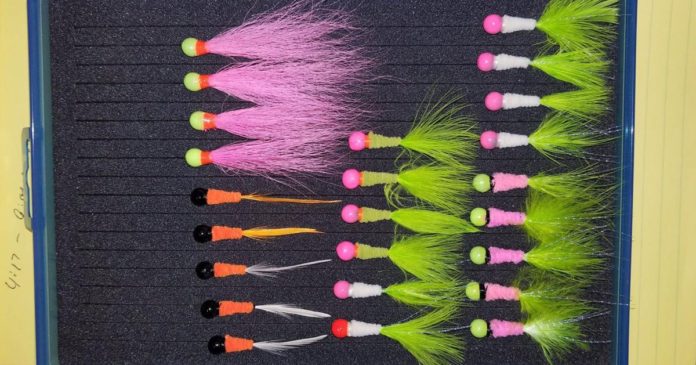It’s that time of year when fishing options start to become limited. Cold nights put a sheet of skim ice that prevents boat launching. The weather has been too mild for the safe ice needed for ice fishing. Recent rains have the streams and rivers flowing a bit too high for reasonable action.
Thankfully, there are fishing-related projects one can pursue when conditions are such to prevent the real thing.
One that comes immediately to mind is tackle craft. Now’s the ideal time to tie flies, assemble lures and build (or repair) fishing rods.
Personally, my winter-related time off the water is often spent tying bucktail jigs. A simple investment of a decent fly-tying vise, scissors, some thread and a bobbin to hold it, assorted colors of deer hair, a bottle of head cement and some leadhead jigs, and you’re on your way.
Round head jigs in eighth- and quarter-ounce cover most of the situations presented on local waters. I’m quite fond of 3/16-ounce, but this in-between size can be hard to find. You can pour your own jigs, but given the relatively low cost of buying unpainted leadhead jigs in bulk, I’ve not seen the need.
Powder coating is a terrific way of painting jigheads and only requires a heat gun (or propane torch) and a cheap toaster oven. With the heat gun you warm up the head of the jig, dip it in powder coat paint and then bake in the oven for 20 to 30 minutes to form a durable finish. When you get on a roll, it’s an easy matter to paint a couple dozen jigs in less than a half hour.
A fly-typing vise that sports a rotating head is helpful when typing bucktails, as it can be rotated as you add hair to the jig and secure it with thread. Typically, I add hair about every 90 degrees, which equates into four individual clumps. This fills in the jig nicely with deer hair, and you can vary different colors to get the result you’re looking for.
With a bit of practice, you’ll get the feel for how much (and how long) to make each clump of hair, how to pinch it down with a thumbnail to get it to rotate around the hook before cinching it down with thread, and how tight to make the securing wraps to be sure the hair stays in place. There are plenty of YouTube videos out there that show the procedure better than I can explain it here.
Simple hair jigs catch fish, but if you want to get creative, you can add a few strands of flashabou for contrast and two hackle feathers to represent legs. These additions might not add up to more bites, but if the bucktail looks good to you, you’ll likely fish it better. At the least it falls into the “can’t hurt” category.
Tackle organization is another task that can fill in the idle time. I use three soft-sided tackle bags as the foundation of my tackle system. The biggest, an older-style Plano Hydro Flo bag, holds up to seven or eight 3500 utility boxes. It serves as my main bag for river smallmouth trips. A somewhat smaller Cabela’s bag sees duty for walleyes primarily. And a smaller Plano bag is geared for crappies. Heavy-duty Ziploc bags hold soft plastics, while the utility boxes hold hard baits and terminal tackle.
Though each of these bags has a primary purpose it’s an easy task to switch boxes and zip lock bags around to suit the day’s fishing and minimize unnecessary tackle that takes up space and adds weight. That said, there are still plenty of days when I fish the whole time with what was tied on the rods I brought along, especially at this time of year when presentation options are limited.
This is just a mere sampling of productive ways of spending time off the water that better prepare you for future outings.
Credit: Source link






























